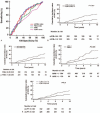Validation of modified fibrosis-4 index for predicting hepatocellular carcinoma in patients with compensated alcoholic liver cirrhosis
- PMID: 30508959
- PMCID: PMC6283079
- DOI: 10.1097/MD.0000000000013438
Validation of modified fibrosis-4 index for predicting hepatocellular carcinoma in patients with compensated alcoholic liver cirrhosis
Abstract
Recently, modified fibrosis-4 index (mFIB-4) and the easy liver fibrosis test (eLIFT) were developed for predicting liver fibrosis in chronic liver disease patients. We evaluated whether the 2 tests can predict hepatocellular carcinoma (HCC) risk in alcoholic liver cirrhosis (ALC) patients.A retrospective cohort of 924 ALC patients was assessed for HCC development. Four non-invasive serum biomarkers, mFIB-4, the eLIFT score, fibrosis-4 index (FIB-4), and aspartate aminotransferase to platelet ratio index (APRI) were tested using time-dependent analysis of areas under receiver operating characteristic curve (AUROC), DeLong, and log-rank tests.During a median 4.8 years of follow-up, HCC occurred in 83 patients (9.0%). For predicting HCC development at 3 years, the mFIB-4 showed a significantly higher AUROC than APRI and eLIFT scores (0.71 vs 0.61 and 0.56, respectively, all P < .05). The AUROCs of the mFIB-4 for HCC development were not significantly different from those of the FIB-4. According to the mFIB-4, the risk of HCC development was significantly stratified by low index (≤4)/high index (>4) (P < .001 by log-rank test).The mFIB-4 showed better predictability of HCC development than APRI and eLIFT scores, and significantly stratified HCC risk in Asian ALC patients.
Conflict of interest statement
No potential conflict of interest relevant to this article was reported.
Figures


Similar articles
-
Fibrosis Index Based on 4 Factors (FIB-4) Predicts Liver Cirrhosis and Hepatocellular Carcinoma in Chronic Hepatitis C Virus (HCV) Patients.Med Sci Monit. 2019 Sep 27;25:7243-7250. doi: 10.12659/MSM.918784. Med Sci Monit. 2019. PMID: 31558693 Free PMC article.
-
Clinical utility of simple non-invasive liver fibrosis indices for predicting hepatocellular carcinoma (HCC) among Egyptian patients.J Clin Pathol. 2015 Feb;68(2):154-60. doi: 10.1136/jclinpath-2014-202462. Epub 2014 Nov 27. J Clin Pathol. 2015. PMID: 25430496
-
Retrospective evaluation of serum markers APRI and AST/ALT for assessing liver fibrosis and cirrhosis in chronic hepatitis B and C patients with hepatocellular carcinoma.Intern Med. 2008;47(7):569-75. doi: 10.2169/internalmedicine.47.0595. Epub 2008 Apr 1. Intern Med. 2008. PMID: 18379139
-
Role of noninvasive tests on the prediction of hepatocellular carcinoma in nonalcoholic fatty liver disease patients without cirrhosis: a systematic review and meta-analysis of aggregate and individual patient data.Eur J Gastroenterol Hepatol. 2025 Mar 1;37(3):358-369. doi: 10.1097/MEG.0000000000002912. Epub 2025 Jan 29. Eur J Gastroenterol Hepatol. 2025. PMID: 39919008
-
Performance of routine risk scores for predicting cirrhosis-related morbidity in the community.J Hepatol. 2022 Aug;77(2):365-376. doi: 10.1016/j.jhep.2022.02.022. Epub 2022 Mar 7. J Hepatol. 2022. PMID: 35271950
Cited by
-
Intravoxel incoherent motion diffusion-weighted imaging for the assessment of renal injury in cirrhotic patients.Quant Imaging Med Surg. 2025 Aug 1;15(8):7281-7295. doi: 10.21037/qims-2024-2918. Epub 2025 Jul 29. Quant Imaging Med Surg. 2025. PMID: 40785862 Free PMC article.
-
Liver injury indicators and subsequent cancer development among non-fatty liver population.Cancer Med. 2023 Jun;12(11):12173-12186. doi: 10.1002/cam4.5910. Epub 2023 Apr 4. Cancer Med. 2023. PMID: 37014815 Free PMC article.
-
Noninvasive Biomarkers for Alcohol-Related Liver Disease-A Proteomic Related Preliminary Report.Indian J Clin Biochem. 2024 Jul;39(3):392-400. doi: 10.1007/s12291-023-01120-9. Epub 2023 Mar 3. Indian J Clin Biochem. 2024. PMID: 39005863 Free PMC article.
-
KASL clinical practice guidelines for noninvasive tests to assess liver fibrosis in chronic liver disease.Clin Mol Hepatol. 2024 Sep;30(Suppl):S5-S105. doi: 10.3350/cmh.2024.0506. Epub 2024 Aug 19. Clin Mol Hepatol. 2024. PMID: 39159947 Free PMC article. No abstract available.
-
Plasma interleukin-17 and alpha-fetoprotein combination effectively predicts imminent hepatocellular carcinoma occurrence in liver cirrhotic patients.BMC Gastroenterol. 2021 Apr 17;21(1):177. doi: 10.1186/s12876-021-01761-1. BMC Gastroenterol. 2021. PMID: 33865328 Free PMC article.
References
-
- European Association for the Study of Liver EASL-ALEH clinical practical guidelines: management of alcoholic liver disease. J Hepatol 2012;57:399–420. - PubMed
-
- Naveau S, Raynard B, Ratziu V, et al. Biomarkers for the prediction of liver fibrosis in patients with chronic alcoholic liver disease. Clin Gastroenterol Hepatol 2005;3:167–74. - PubMed
-
- Ho AM, Contardi LH. Pure alcoholic fatty liver and progression to cirrhosis or fibrosis. Lancet 1995;346:1562–3. - PubMed
-
- N’Kontchou G, Paries J, Htar MT, et al. Risk factors for hepatocellular carcinoma in patients with alcoholic or viral C cirrhosis. Clin Gastroenterol Hepatol 2006;4:1062–8. - PubMed
-
- Masarone M, Rosato V, Dallio M, et al. Epidemiology and natural history of alcoholic liver disease. Rev Recent Clin Trials 2016;11:167–74. - PubMed
Publication types
MeSH terms
Substances
LinkOut - more resources
Full Text Sources
Medical

